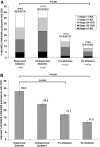Prevalence of chronic kidney disease in US adults with undiagnosed diabetes or prediabetes
- PMID: 20338960
- PMCID: PMC2849697
- DOI: 10.2215/CJN.07891109
Prevalence of chronic kidney disease in US adults with undiagnosed diabetes or prediabetes
Abstract
Background and objectives: Prevalence of chronic kidney disease (CKD) in people with diagnosed diabetes is known to be high, but little is known about the prevalence of CKD in those with undiagnosed diabetes or prediabetes. We aimed to estimate and compare the community prevalence of CKD among people with diagnosed diabetes, undiagnosed diabetes, prediabetes, or no diabetes.
Design, setting, participants, & measurements: The 1999 through 2006 National Health and Nutrition Examination Survey is a representative survey of the civilian, noninstitutionalized US population. Participants who were aged > or =20 years; responded to the diabetes questionnaire; and had fasting plasma glucose (FPG), serum creatinine, and urinary albumin-creatinine ratio measurements were included (N = 8188). Diabetes status was defined as follows: Diagnosed diabetes, self-reported provider diagnosis (n = 826); undiagnosed diabetes, FPG > or =126 mg/dl without self-reported diagnosis (n = 299); prediabetes, FPG > or =100 and <126 mg/dl (n = 2272); and no diabetes, FPG <100 mg/dl (n = 4791). Prevalence of CKD was defined by estimated GFR 15 to 59 ml/min per 1.73 m(2) or albumin-creatinine ratio > or =30 mg/g; adjustment was performed with multivariable logistic regression.
Results: Fully 39.6% of people with diagnosed and 41.7% with undiagnosed diabetes had CKD; 17.7% with prediabetes and 10.6% without diabetes had CKD. Age-, gender-, and race/ethnicity-adjusted prevalence of CKD was 32.9, 24.2, 17.1, and 11.8%, for diagnosed, undiagnosed, pre-, and no diabetes, respectively. Among those with CKD, 39.1% had undiagnosed or prediabetes.
Conclusions: CKD prevalence is high among people with undiagnosed diabetes and prediabetes. These individuals might benefit from interventions aimed at preventing development and/or progression of both CKD and diabetes.
Figures


Comment in
-
Prediabetes, prehypertension ... is it time for pre-CKD?Clin J Am Soc Nephrol. 2010 Apr;5(4):557-9. doi: 10.2215/CJN.01650210. Epub 2010 Mar 25. Clin J Am Soc Nephrol. 2010. PMID: 20338961 No abstract available.
References
-
- US Renal Data System: USRDS 2009 Annual Data Report: Atlas of Chronic Kidney Disease and End-Stage Renal Disease in the United States, Bethesda, National Institutes of Health, National Institute of Diabetes and Digestive and Kidney Diseases, 2009
-
- Centers for Disease Control and Prevention: National diabetes fact sheet: General information and national estimates on diabetes in the United States, 2007, Atlanta, US Department of Health and Human Services, Centers for Disease Control and Prevention, 2008. Available at: http://www.cdc.gov/diabetes/pubs/pdf/ndfs_2007.pdf Accessed February 1, 2009
-
- Kramer HJ, Nguyen QD, Curhan G, Hsu CY: Renal insufficiency in the absence of albuminuria and retinopathy among adults with type 2 diabetes mellitus. JAMA 289: 3273–3277, 2003 - PubMed
Publication types
MeSH terms
Substances
Grants and funding
LinkOut - more resources
Full Text Sources
Medical

